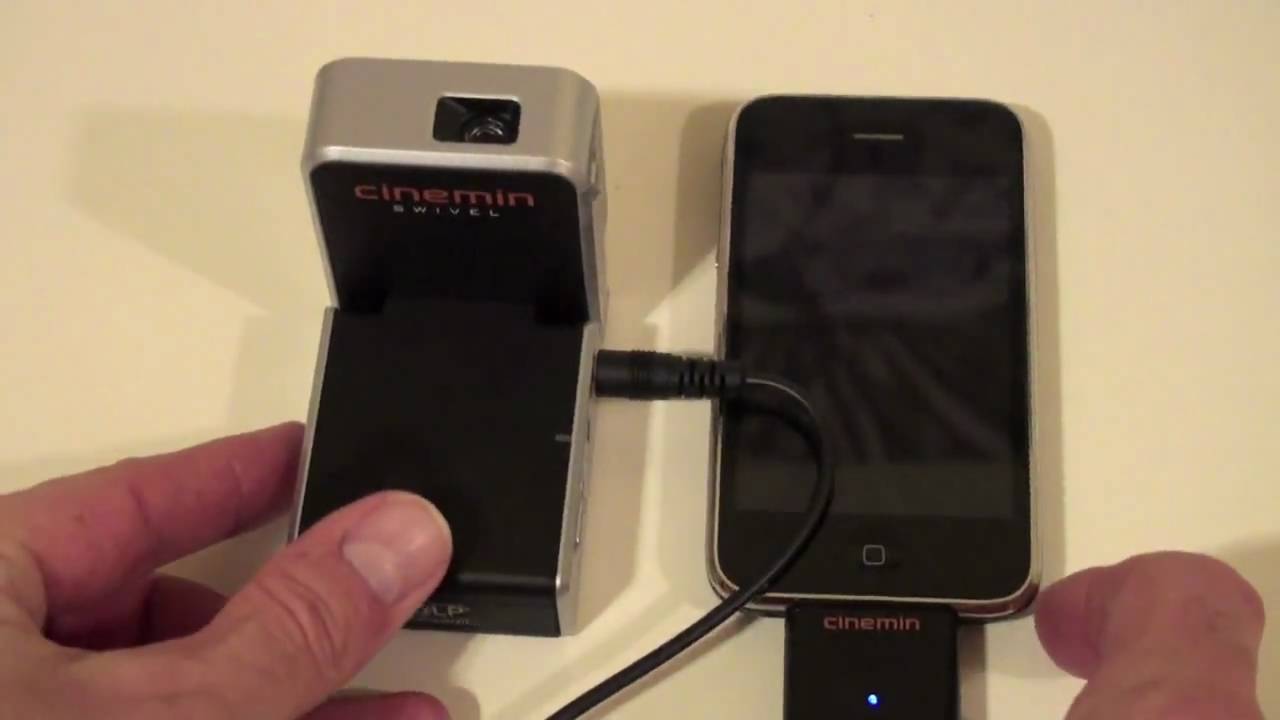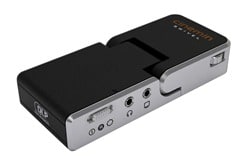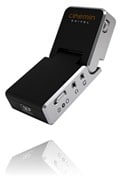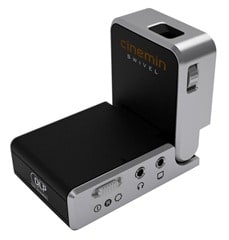I must admit, I have never heard of the WowWee Cinemin Swivel until my step-brother-in-law sent me a Facebook message asking me if I had ever tried it out. I told him that I hadn’t but that I would try to get my hands on one for a review and let him know my thoughts. Funny thing is, I actually had heard of WowWee before (FlyTech Dragonfly) but just not about this specific product. The Cinemin Swivel is definitely NOT a toy (the way the Dragonfly is, sort of). The Cinemin is a pocket-sized DLP projector which hooks up to a variety of A/V sources including iPods, iPhones, video game consoles and laptops. It is called a pico projector which are newer handheld devices that can project digital images or movies.
As my quest to get a Cinemin in-hand continued, I did a quick review of their website and reached out to their PR firm. My impression was that the Cinemin is a pretty HOT review item, but luckily they bumped me up on the waitlist and I received my evaluation unit fairly quickly. Let’s set the record straight, this is not a splurge type of purchase. The MSRP is $349 (currently selling for about $300). But when you think about the prices of larger digital projectors on the market, it’s pretty reasonable. Now, before I go into how well (or not well) this device works, let’s consider the many possible applications the Cinemin could be used for:
- A portable business projector
- In your Kids’ rooms instead of a TV
- On the back of airplane seat or car seat for mobile movie viewing
- On the side of a tent – "can’t you just leave your technology at home for once?!"
- On the ceiling above a bed for true "relaxation"
This device is really compact. It measures only 4.7†x 2.1†x 0.9†and weighs about 6 ounces. The size is about that of 2 iPhones stacked on top of each other (see the video below for details). I figured I would get the tech specs out of the way before going into the really fun things about this device.
- DLP Projection by Texas Instruments
- 480 x 320 (HVGA) resolution
- Manual focus
- LED source of lighting
- 8 ANSI lumens of brightness
- A Contrast ratio of 1000:1
- Viewable range of 8.5 feet
- Diagonal image size is about 6†~ 60â€
- 3:2 aspect ratio
- Power consumption: ~ 3 watts
- Lamp life: > 20,000 hours
It also sports a 0.5 watt mono audio speaker with a volume adjustment on the side. The battery, according to the WowWee site, lasts about 2 hours and can be recharged either by plugging into a computer via a USB connector or into the wall using a wall plug adapter (for the USB cable). The Cinemin comes with a variety of world plug adapters as well, making this a great device to just throw in a bag when travelling overseas. So, you can use it to project on your seat in the airplane and then once you are relaxing in the hotel, lying in bed, watch a movie on the ceiling from your iPod. Pretty neat!
Functionality
So, how well does the Cinemin work? Pretty well actually. When I first unpacked it, I couldn’t, for the life of me, figure out how to hook it up to my iPhone or iPod. I was expecting just to be able to connect it via a USB cable. Eventually, I found the special iPod/iPhone connector (note, it’s very small so it is very easy to lose!) and plugged in my iPhone. You simply dial though the menus on the iPod or iPhone until you reach some video content, then, the Cinemin takes over and starts outputting the video from the micro lens. (Remember to turn on the Cinemin first, there is a 3-position on/reverse/off switch on the side.)
You need to be in a fairly dark room to fully enjoy the best picture quality. At 8 ANSI lumens, it is NOT very bright and the picture will definitely get lost during the day or in a bright room (especially at longer distances). However, if you are in a room at night (projecting about 4-7 feet) or are projecting it fairly closely with some ambient lighting (e.g., 1-3 feet), you can completely use the Cinemin without issue.
The audio from your video playback on an iPod is piped through the mono audio speaker as well, and you can adjust the volume right on the side. This is a great feature to have if the viewer is just you or everyone is close by (e.g., in a tent or something). However, you might want to invest in a portable speaker as well to increase the volume output. There is a connector on the side of the Cinemin that lets you plug in headphones (or a speaker like this).
The Cinemin is hinged in the middle which means that you can easily adjust the angle of projection to be straight forward, at an angle or 90 degrees straight up to the ceiling (as I mentioned, great for bed viewing).
There is a manual focus dial to help you adjust the crispness of the image being projected as well. The output, once properly focused, does produce quite a crisp view (not HD but definitely quite good).
Another nifty thing that you can do is flip the image using the "reverse" switch. This means that if you want to project from behind (say perhaps using a sheet as an impromptu screen) you could reverse how the movie looks so that from the other side it looks correct. Hmmm, I see lots of potential here for a Halloween decoration enhancement (e.g., projecting on smoke or fog).
Below is a quick video that shows some of the functionality and attempts to provide a view of how well the video output is.
My Final Thoughts
I think that this space will start to really heat up in 2010 as more cell phones and gaming devices become more powerful, and have the ability to store/display HD quality video. The problem with these smaller projectors is that they still suck up a lot of battery so they are only really good for about 2 hours of video (enough for a movie). To really go far, battery needs to be improved to last 4-5 hours, and there must be an easy way for interoperability with many devices, or devices need to start standardizing (perhaps the Light Peak technology that is being finalized could be a good way to standardize connection and provide high bandwidth transfers between devices). I found the many cords and connectors that I had to potentially carry with this device to be more in size than the Cinemin itself. It would be great if they could develop one that has much more of the connectivity built in.
The packaging is pretty nice, but I was a bit surprised with the documentation, or lack there of. The documentation is pretty sparse, consisting of just a few pages and most are graphical. I would have expected a bit more.
The current generation of the Cinemin is a great first start. It’s small, portable and throws enough light that videos can be seen quite well in dark rooms. It can attach to just about any device that contains video which means that an "instant theater" can be set up just about anywhere. While it’s a bit pricy at $349 (actually the WowWee site is showing it’s price at $299.99 and is listed on Amazon for $289.99).
DISCLOSURE OF MATERIAL CONNECTION: http://cmp.ly/1. My full review policy and disclosure can be found on my About page.
HTD says: The Cinemin is perfect for someone who travels frequently, for parents that need quick A/V theater on-the-go, by someone who does not have the space for a big screen TV (or the budget for one either), or for gadget lovers like me.






4 comments
CAH
I have wireless headphones with my iTouch, would I still be able to use these?
Sdhilton
Why CAN'T I PRINT out your articles?
uggs outlet
I totally agree the standpoint of upstairs, and I believe this will be a trend. I often come this forum , rom here I learn much and know the newest tide!
<a href=” http://www.eeadie.com“ >eeadie
the content here constantly update and I love it! Another I know some websites which often update their contents, you guys should browse if you are free.
air max shoes
Well , the view of the passage is totally correct ,your details is really reasonable and you guy give us valuable informative post, I totally agree the standpoint of upstairs. I often surfing on this forum when I m free and I find there are so much good information we can learn in this forum!
aesthetic-appeal